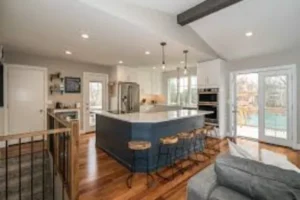The Future of Fix-and-Flip in Washington, DC: How 100% Financing Actually Works


Image from Pixabay
Washington, DC remains one of the most inventory-constrained, appreciation-friendly markets in the U.S., especially for rowhomes and small multifamily near transit. For experienced operators, 100% financing on acquisition and rehab can turn tight deal flow into repeatable outcomes: faster closings, less equity tied up, and a bigger pipeline. If you’re evaluating capital partners for Washington DC fix and flip loans, the guide below breaks down how true “no-money-down” structures are underwritten, what you’ll need to qualify, and the deal math lenders actually trust.
What 100% Really Means (and How Lenders De-Risk It)
“100% financing” in fix-and-flip rarely means unlimited leverage. In practice, it’s a structure that covers up to 100% of purchase and rehab costs, but still respects conservative caps tied to after-repair value (ARV).
Typical guardrails you’ll see:
- LTC (Loan-to-Cost): Up to 100% combined on purchase + rehab for experienced sponsors.
- ARV cap: Total loan limited to ~65-75% of ARV (70% is common).
- Draws: Rehab funds are disbursed in draws against completed work, based on an approved budget and inspections.
- Skin-in-the-game alternatives: Even when cash at close is minimal, lenders may require proof of post-close liquidity, a rehab reserve, or collateral cross-pledges on other properties.
Why lenders fund 100% for repeat operators: credibility of execution. If your track record shows on-time renovations, accurate budgets, and days-on-market (DOM) discipline, the perceived risk drops, making a 100% LTC structure sensible within the ARV cap.
Who Qualifies in DC: The Sponsor Profile That Gets a “Yes”
Experience matters more than anything else. Lenders price the operator, not just the asset.
Signals that move you to the front of the line:
- 2-5 completed flips in the last 24 months (ideally in urban infill like Petworth, Shaw, Capitol Hill, Brookland).
- Documented budgets vs. actuals (you hit timelines and didn’t blow contingencies).
- Reliable contractor bench with permits history and lien-waiver discipline.
- Clean title/scope (no unresolved stop-work orders; clear plan for historic review when relevant).
- Liquidity after close (even with 100% LTC, most lenders want 3-6 months of interest payments in cash or LOCs).
Credit & entities: Mid-600s+ FICO helps, but entity structure (LLC with proper operating agreement), insurance, and a sensible exit plan (list price path, broker letter, staging budget) carry real weight.
The DC Deal Math: A Rowhome Example
Imagine a two-story rowhome in Mt. Vernon Triangle/Shaw.
- Purchase price: $650,000
- Rehab budget: $180,000 (systems + kitchen/baths + backyard + façade)
- All-in cost: $830,000
- Projected ARV: $1,150,000 (supported by three nearby 90-day comps within 0.25 mi)
With a 100% LTC structure capped at 70% ARV:
- Max loan at 70% ARV: $805,000
- Your costs: Lender funds $650k purchase (at close) + $155k of the $180k rehab (via draws); you cover a $25k rehab gap (or bring a small gap lender/partner) plus closing costs, points, interest, and staging.
Timeline realities (best case):
- 10-15 days to close (title, appraisal, scope review).
- 12-16 weeks construction (permits + historic review if façade changes).
- 2-4 weeks listing prep and DOM to contract, assuming competitive pricing and staging.
The “100%” pitch works here because you’re cash-light at acquisition, your gap is small and time-bounded, and the ARV cushion absorbs ordinary market noise.
Underwriting Checklist: What DC Lenders Actually Verify
1) Comps quality, not just price: similar block feel, lot depth, finished basement legality, bed/bath parity.
2) Permit path: electrical, plumbing, structural, plus historic approvals in designated districts.
3) Scope realism: contingency of 10-15% and line items for lead/asbestos remediation common in older housing stock.
4) Contractor credentials: license, insurance, W-9, and a draw schedule with milestones (rough-in, drywall, finishes, punch).
5) Exit realism: listing agent’s BPO, staging plan, and price bands that clear within 30-45 DOM.
Pro tip: create a one-page “Deal Dossier” (address, photos, comp grid, scope, draws, timeline, exit plan). It shortens credit boxes and sets you apart from hobbyist flippers.
Rates, Fees, and Fine Print: What to Expect
- Interest: Usually interest-only, floating; seasoned sponsors may see single-digit rates, newer operators low double-digits.
- Origination/points: 1.5-4.0 points depending on experience and leverage.
- Prepay: Minimal or none; some lenders require 3-month minimum interest.
- Draw inspections: Third-party or internal; budget variances require change orders.
- Reserves: Taxes/insurance escrow, and sometimes interest reserves capitalized into the loan.
The winning move is to ask lenders for full annualized APR equivalents (fees + points + expected interest by timeline). That normalizes quotes across different structures.
Compliance, Permits, and Risk: Get Ahead of DC’s Paperwork

Image from Pixabay
DC is efficient when the scope is clean, and unforgiving if you wing it. Build these into your playbook:
- Permit calendar: submit early; sequence structural, MEP, and façade items to avoid re-submits.
- Neighbor relations: plan for party-wall access agreements; delays here can stall your critical path.
- Lien waivers: collect on every draw; avoid mechanics-lien surprises at sale.
- Historic considerations: window profiles, cornices, and masonry cleaning can trigger reviews; budget time and money.
Alternatives and Complements: When 100% Isn’t the Only Path
Even if you can command 100% LTC, it’s wise to compare structures:
- 90% LTC with cheaper money: Lower points/rate can outperform 100% when your cash position is strong.
- Gap equity partner: Profit-share in exchange for covering the small rehab gap + reserves.
- Owner-occupied rehab as a comp for market understanding: While not for flippers, HUD’s 203(k) Rehabilitation Mortgage Insurance outlines a government-backed model for purchase-plus-renovation financing that informs scope planning and inspection cadence. Studying its inspector/draw rhythm helps you design clean scopes, even on investor loans.
Execution Blueprint: A 60-Day Close-to-List Plan
Days 1-10: Lock the capital and the scope
- Term sheet, appraisal ordered, contractor bid locked, permit pre-check.
- Build your “Deal Dossier”; line up staging vendor.
Days 11-20: Close and gut
- Close. Secure site, demo, abatement if any, order long-lead items (windows, cabinets, tile).
- Draw #1 after demo + rough framing start.
Days 21-42: Rough-ins & inspections
- Electrical, plumbing, HVAC rough-ins; inspections cleared.
- Draw #2; confirm façade/historic items are on schedule.
Days 43-56: Drywall to finishes
- Drywall, flooring, tile, millwork, paint.
- Draw #3; schedule photography and staging date.
Days 57-60: Punch & list
- Final clean, staging install, pro photos, list at a price aligned with “best comp minus DOM friction.”
- Marketing blitz: broker caravan, weekend opens, twilight photos.
Execute this cadence with consistency, and lenders will lean in further on leverage, speed, and pricing.
Common Deal Killers (and How to Avoid Them)
- ARV optimism: If your best comp needed a rear addition but your plan does not, trim ARV now, not later.
- Budget drift: Lock materials early; DC supply chains stabilize when you order fast-moving SKUs at demo.
- Permit surprises: Structural “discoveries” after demo? Call the engineer before you call the lender; change orders approved quickly avoid cash crunches.
- Staging neglect: In DC’s core, staged homes sell faster and closer to list, skip it at your peril.
For experienced renovators, DC’s fix-and-flip market rewards speed, clarity, and repeatable process. With a credible track record and a tight scope, 100% financing can be a powerful force multiplier, keeping your equity light and your pipeline full. Underwrite to conservative ARVs, respect the permit path, and communicate like a pro with your lender. Do that consistently, and you’ll cycle capital faster, win more deals, and turn constrained inventory into durable returns, one well-executed rowhome at a time.







